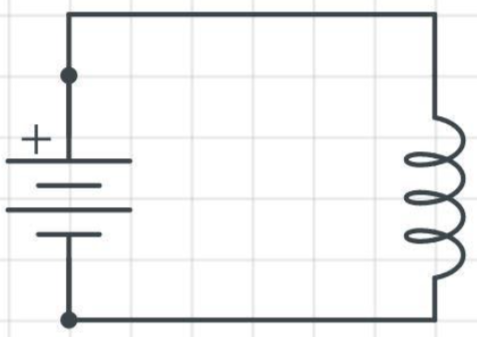
In the electrical method of magnetization, a strong electric current is used which is:
A). A direct current (DC)
B). An alternating current (AC)
C). Can be either AC or DC
D). It depends on whether the magnet is to be permanent or temporary
Answer
576k+ views
Hint: In order to answer the question, we should be having an idea about the concept of the electrical method of magnetization. Once, we know the aim, purpose, and properties of this concept we will be able to answer this question.
Complete step-by-step solution:
The electrical method of magnetization involves the process in which magnetization is obtained, with the help of direct current. The direct current is flown into a solenoid. By solenoid, we mean a long-insulated wire which is coiled into a cylinder. As soon as the direct current is flown, a magnetic field is produced inside the coil. This magnetic field that is produced is uniform in strength and in the direction as well. This turns the solenoid into a temporary magnet.

Hence, we can say that the correct answer is Option A.
In the answer have mentioned the words temporary magnet. By temporary magnet we mean the magnet that remains magnetized for a small period of time as compared to that of the permanent magnet.
Additional information:
The core or the shaft in the solenoid energize as a magnet when you apply current in the coil. As we all know that the magnet has two poles as NORTH and SOUTH. The poles depend on the direction of the current flow in the coil. In DC, there will be no change in the current flow direction. So, there will be no or less flux change. But in the case of AC, as the direction of the current changes frequently, there will be a flux difference which tries to oppose the current flow. This will raise vibrations and improper functionality of the solenoid that is designed for DC.
Note: As we have seen that the solenoid behaves as a magnet only when the direct passes through it. Therefore, it is quite evident that the magnetic field within the solenoid will depend on the current and the density of the turns.
Complete step-by-step solution:
The electrical method of magnetization involves the process in which magnetization is obtained, with the help of direct current. The direct current is flown into a solenoid. By solenoid, we mean a long-insulated wire which is coiled into a cylinder. As soon as the direct current is flown, a magnetic field is produced inside the coil. This magnetic field that is produced is uniform in strength and in the direction as well. This turns the solenoid into a temporary magnet.

Hence, we can say that the correct answer is Option A.
In the answer have mentioned the words temporary magnet. By temporary magnet we mean the magnet that remains magnetized for a small period of time as compared to that of the permanent magnet.
Additional information:
The core or the shaft in the solenoid energize as a magnet when you apply current in the coil. As we all know that the magnet has two poles as NORTH and SOUTH. The poles depend on the direction of the current flow in the coil. In DC, there will be no change in the current flow direction. So, there will be no or less flux change. But in the case of AC, as the direction of the current changes frequently, there will be a flux difference which tries to oppose the current flow. This will raise vibrations and improper functionality of the solenoid that is designed for DC.
Note: As we have seen that the solenoid behaves as a magnet only when the direct passes through it. Therefore, it is quite evident that the magnetic field within the solenoid will depend on the current and the density of the turns.
Recently Updated Pages
Master Class 12 English: Engaging Questions & Answers for Success

Master Class 12 Economics: Engaging Questions & Answers for Success

Master Class 12 Social Science: Engaging Questions & Answers for Success

Master Class 12 Maths: Engaging Questions & Answers for Success

Master Class 12 Chemistry: Engaging Questions & Answers for Success

Master Class 12 Business Studies: Engaging Questions & Answers for Success

Trending doubts
What are the major means of transport Explain each class 12 social science CBSE

Which are the Top 10 Largest Countries of the World?

Draw a labelled sketch of the human eye class 12 physics CBSE

Explain sex determination in humans with line diag class 12 biology CBSE

The pH of the pancreatic juice is A 64 B 86 C 120 D class 12 biology CBSE

Explain sex determination in humans with the help of class 12 biology CBSE




